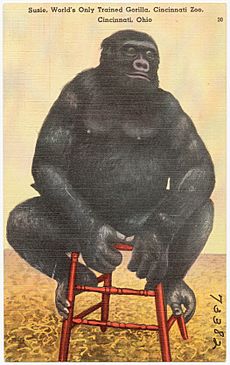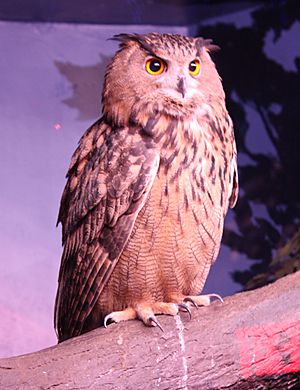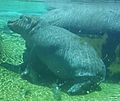Cincinnati Zoo and Botanical Garden facts for kids
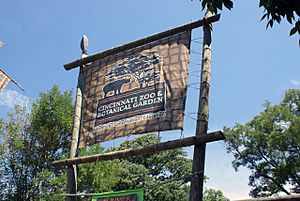 |
|
| Date opened | 1875 |
|---|---|
| Location | Cincinnati, Ohio, USA |
| Land area | 65.4 acres (26.5 ha)+ |
| Coordinates | 39°08′42″N 84°30′29″W / 39.145°N 84.508°W |
| No. of animals | 1,896 |
| No. of species | 500+ |
| Annual visitors | 1.2 million+ |
| Memberships | AZA, WAZA |
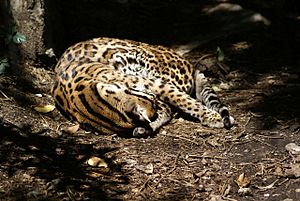
The Cincinnati Zoo and Botanical Garden is a famous zoo in Cincinnati, Ohio, USA. It opened in 1875, making it one of the oldest zoos in the country. Some people say it's the second oldest, opening just 14 months after the Philadelphia Zoo.
This amazing zoo covers over 65 acres of land. It is home to about 2,800 animals from over 500 different species. You can explore more than 30 indoor and outdoor attractions here. The Cincinnati Zoo is also known for helping to breed rare animals. For example, it was the first zoo to breed California sea lions and American bison back in 1878. It's also the only place in the Western Hemisphere where one, two, and even three Sumatran Rhinoceroses have been born!
Contents
History of the Zoo
The Cincinnati Zoo first opened its doors in 1875. It started with 66 acres of land. Some of the richest people in Cincinnati owned it back then. Today, the zoo has around 500 different animal species. This adds up to about 1,900 animals in total. The zoo also shows off over 6,000 types of plants. You might even see Indian blue peafowls walking freely around the zoo grounds!
A Green Zoo
In the late 2000s, the Cincinnati Zoo earned a special title. It was named the Greenest Zoo in America! This was because of all their efforts to "go green" and protect the environment.
The zoo has ten special garden exhibits. Plus, there are over 5,000 other plant species all over the zoo. In 2010, the zoo finished building over 6,000 solar panels. These panels are in the main parking lot. It's one of the biggest displays of solar panels in the world! The zoo also makes sure that the plants in each animal exhibit match the animals' natural homes. For example, you'll see Florida marsh plants in the Manatee Springs area. There are also bamboo gardens for the red pandas. And California bushes grow near the sea lion exhibit.
Outdoor Adventures
Wildlife Canyon and Sumatran Rhinos

Since 1989, Wildlife Canyon has shown off rare and unique hoofed animals. These animals come from many parts of the world. The area has six different paddocks. They are at the bottom of a steep canyon built in 1942. Visitors can walk among emus, camels, Asian wild horses, Sichuan takins, river hogs, and the very rare Sumatran rhinoceros. Did you know that every Sumatran rhino living in the U.S. was born right here at the Cincinnati Zoo?
Eagle Eyrie
This attraction opened in 1970. Here, you can walk into large flight cages. These cages are home to two of the biggest flying birds on Earth: condors and sea eagles. When you enter the flight cages, you'll be on a raised viewing deck. Nothing will be between you and these amazing birds! The Cincinnati Zoo is the only place in North America to breed the Steller's sea eagle. They have even successfully released some of these birds into the wild. You might see two eagle chicks nesting in the sea eagle flight area.
Monkey Island
Monkey Island is a special place for a large group of snow monkeys, also known as Japanese macaques. It's a man-made rock island surrounded by a moat. This island is over 80 years old. It was one of the first monkey exhibits in North America that didn't use bars!
Gorilla World
Gorilla World tries to feel like a rainforest in central Africa. It opened in 1978. It was one of the first natural gorilla exhibits in the country. The main area is a huge 30,000-square-foot forest home. It has tropical plants, waterfalls, meadows, logs, and vines. These are all for the zoo's famous Lowland gorillas to enjoy. The zoo also holds a record for the most gorilla births in one year. They had six babies in 1996! You can also see colobus monkeys and crowned guenons here.
Rhino Reserve
The Rhino Reserve area has many different enclosures. These are home to various African animals from the Savannah. You'll also find Asian forest species here. This reserve first opened in 1997.
Jungle Trails

Jungle Trails takes you through a 2.5-acre natural rainforest. It's full of rare and exotic wildlife. You'll also see hundreds of plant species from Asia and Africa. Each part of the exhibit has outdoor and indoor areas. You can get great views of the zoo's rare primates. These include Bornean orangutans, bonobos, Müeller's and lar gibbons, and different types of lemurs. You can also see Angolan colobus monkeys, aye-ayes, and Francois langurs. Many of these animals swing, crawl, and jump from branch to branch!
Jungle Trails also has some of the zoo's birds, reptiles, and insects. You might spot lesser adjutant and saddle-billed storks, pelicans, and white-naped ravens. Other cool animals include cloud rats, sugar gliders, and large-spotted genets. The attraction won a special award in 1994, just a year after it opened.
Arctic Animals
The main animals in this area are the zoo's two polar bears. Their names are Little One (a male) and Berit (a female). You can watch the bears swim in their huge 70,000-gallon pool. There are many places to watch them. You can see them underwater, across a moat, or even on land through just 3 inches of glass! Next to the bears, there's a bird area with a bald eagle.
Bear Hill
The Bear Hill grottoes were built in 1937. They feature two bear species from North and South America: black bears and Andean bears. The exhibits are built on a hillside. This helps create natural mountain homes for the bears. It also keeps the sun from shining too brightly into their areas.
Lorikeets
In Lorikeet Landing, you'll find a mesh-enclosed bird home. It was built in 1962 and updated in 2006. This area is filled with hundreds of colorful birds. They are native to Australia and New Guinea.
Wolves
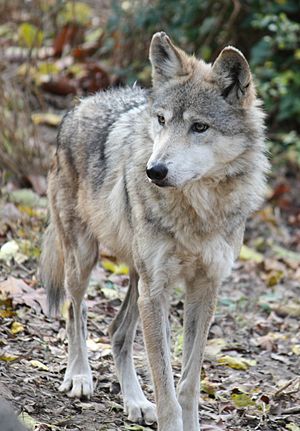
You can hike through the Wolf Woods to see animals from North America. This area opened in 2005 after some changes to the Otter Creek exhibit.
Children's Zoo
The Children's Zoo is a fun place for kids and young animals. It opened in the 1950s and was updated in 1985 and 2008. The zoo's nursery often has baby animals from different zoos. These young animals sometimes get to walk around the zoo with their keepers! The play area for children has small homes for three types of armadillos and three types of tortoises.
Kids can also enter the Petting Zoo. Here, they can feed and interact with dwarf goats and doll sheep. Blakely's Barn was added in 1997. It has indoor and outdoor areas with close views of four-horned sheep, cattle, llamas, miniature cows, miniature donkeys, and alpacas. At the entrance to this area is Penguin Walkabout, which opened in 1985. Little and black-footed penguins live here.
Gibbon Islands
This attraction shows off rare and endangered apes. You can watch them swing on two large jungle gyms. These gyms are on two round islands built in 1972. You can walk on a wooden platform over the lake to get a closer look. Listen for the zoo's loudest animals, siamangs and buff-cheeked gibbons! You can hear them from all over the park.
Red Panda Habitat
Some of the zoo's red pandas came from the Beijing Zoo in 1985. They live in two exhibits that look like their natural homes in China. The Cincinnati Zoo has bred over 70 red pandas!
Elephant Reserve
The Elephant Reserve opened in 2008. It's an area that has shown elephants and other large animals since the zoo first opened in 1875. The main part of the exhibit is a 1.5-acre home for female elephants. You can see the zoo's stars: Schottzie, Mai-Thai, and Jati. The exhibit has a 60,000-gallon pool next to a viewing area. Sabu, the male elephant, has his own home that was added in 2006.
Swan Lake
Swan Lake is the biggest body of water at the zoo. It's home to many native waterfowl from Cincinnati. Birds like mallards, pintails, and swans can live freely on the lake. The historic train also circles around them. At one end of the lake is Crane Island. This island is home to a Japanese species called red-crowned cranes. Wetland Trails is another area. It's a natural home for a sandhill crane.
Indoor Exhibits
Reptiles
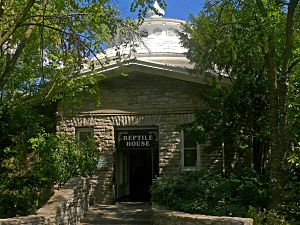
The Reptile House is the oldest zoo building still standing in America. Here, you can see many different monitors, pythons, mambas, tortoises, and even frogs and salamanders behind glass. In the middle of the building, there's an open-topped exhibit. Alligators and sliders live together there.
Some of the snakes you might see include Dumeril's ground boas, green tree pythons, and king cobras. For lizards, there are Solomon Islands skinks and Madagascar giant day geckos. You can also find Pancake tortoises and Galapagos tortoises. Among the amphibians are Texas blind salamanders and Amazon milk frogs.
Night-time Animals
This area features animals that are active at night. You'll see an eagle owl, vampire bats, and giant fruit bats. There are also many types of cats like endangered Pallas' cats, clouded leopards, Brazilian ocelots, and sand cats. Other interesting animals include fossas, aardwolves, bearcats, and fennec foxes. Rare primates like pottos and greater bushbabies also live here. You might even spot Aardvarks and a Burmese python.
Insects
The World of the Insect, or Insectarium, has a huge collection of six-legged creatures!
- Ants: You can see Leaf-cutting ants and Velvet ants.
- Beetles: Look for the Blue Death Feigning Beetle, Hercules beetle, and Emerald beetle.
- Cockroaches: The Madagascar hissing cockroach is a popular one.
- Scorpions: There are Emperor scorpions and Giant desert hairy scorpions.
- Spiders: Check out the Brazilian Salmon Pink Birdeater and Mexican Red-knee Tarantula.
- Walking Sticks: See the Giant Walking Stick and Giant Spiny Stick Insect.
Monitor Lizards
This area features Monitor lizards of all sizes. You can see dwarf, green, quince, and crocodile monitors. In the largest area, you'll find Hudo, a huge Komodo dragon! Each indoor exhibit has glass walls and real plants. You can also see the Komodo dragon outdoors near the exit.
Tropical Swamp Life
Built in 1999, this area is like the Everglades in Florida. Manatee Springs is home to many swamp animals from Florida. The first part of the building is a greenhouse. It feels and sounds just like a freshwater swamp. You can see American alligators, American crocodiles, and Florida cooter turtles. You can even view them underwater! There's a bridge over a deep pool where you might see an alligator snapping turtle right below you.
The Manatee exhibit has a huge 120,000-gallon tank. It gives you a close-up view of Wooten and Betsy, the rare Florida manatees. Other animals here include Alligator gars and Florida softshell turtles. The Infamous Alien Invaders tank shows plants and animals that were brought into Florida's ecosystems. You might see oscar fish and red-eyed piranhas.
Birds
The bird exhibits feature over 50 species! You'll find birds from the Amazon to the Antarctic Coast. You can see owls, macaws, bird-of-paradises, hornbills, parakeets, and even three types of penguins. There are two walk-through aviaries. You can also see birds in open-fronted areas or behind glass, sometimes with underwater views.
- The Amazon is a large greenhouse with free-flying birds from South America. You can walk through and see them from a tall boardwalk.
- Australasia is another walk-through area for birds from New Guinea and Australia. You might see giant fruit bats hanging from the ceiling.
- The Arctic Islands and Arctic Sea Cliff areas look like the rocky shores of the Arctic. You can see birds like crested auklets and puffins.
- The Sub-antarctic Coast is a cold-weather exhibit. It's home to birds from South America and Antarctica. You can see king penguins and southern rockhopper penguins here.
Rainforest
Discovery Forest is a 4,500-square-foot tropical rainforest. It's a unique, two-story circular room. It looks like a Latin American rainforest. In 2008, new animals were added. These included a two-toed sloth, a blue-and-gold macaw, and boa constrictors. These animals help show how plants and animals depend on each other.
The Future of the Zoo
'Africa'
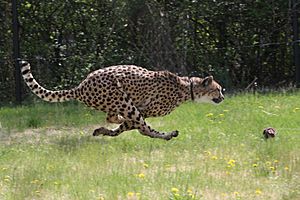
The zoo is planning a huge new exhibit called 'Africa'. It will be the biggest animal exhibit in the zoo's history, covering almost 8 acres!
In one part of the plan, the zoo will add a large Savannah area. It will be full of amazing African hoofed animals. You'll see zebras, gazelles, and elands. There will also be some of the world's largest birds, like ostriches and Marabou storks. This part of the exhibit was planned to open in 2014.
The final part of the plan will bring Nile hippos and crocodiles. The hippo area will let visitors see the hippos both above and below the water. This last area was planned to open in 2015.
Images for kids
See also
 In Spanish: Jardín botánico y zoo de Cincinnati para niños
In Spanish: Jardín botánico y zoo de Cincinnati para niños


